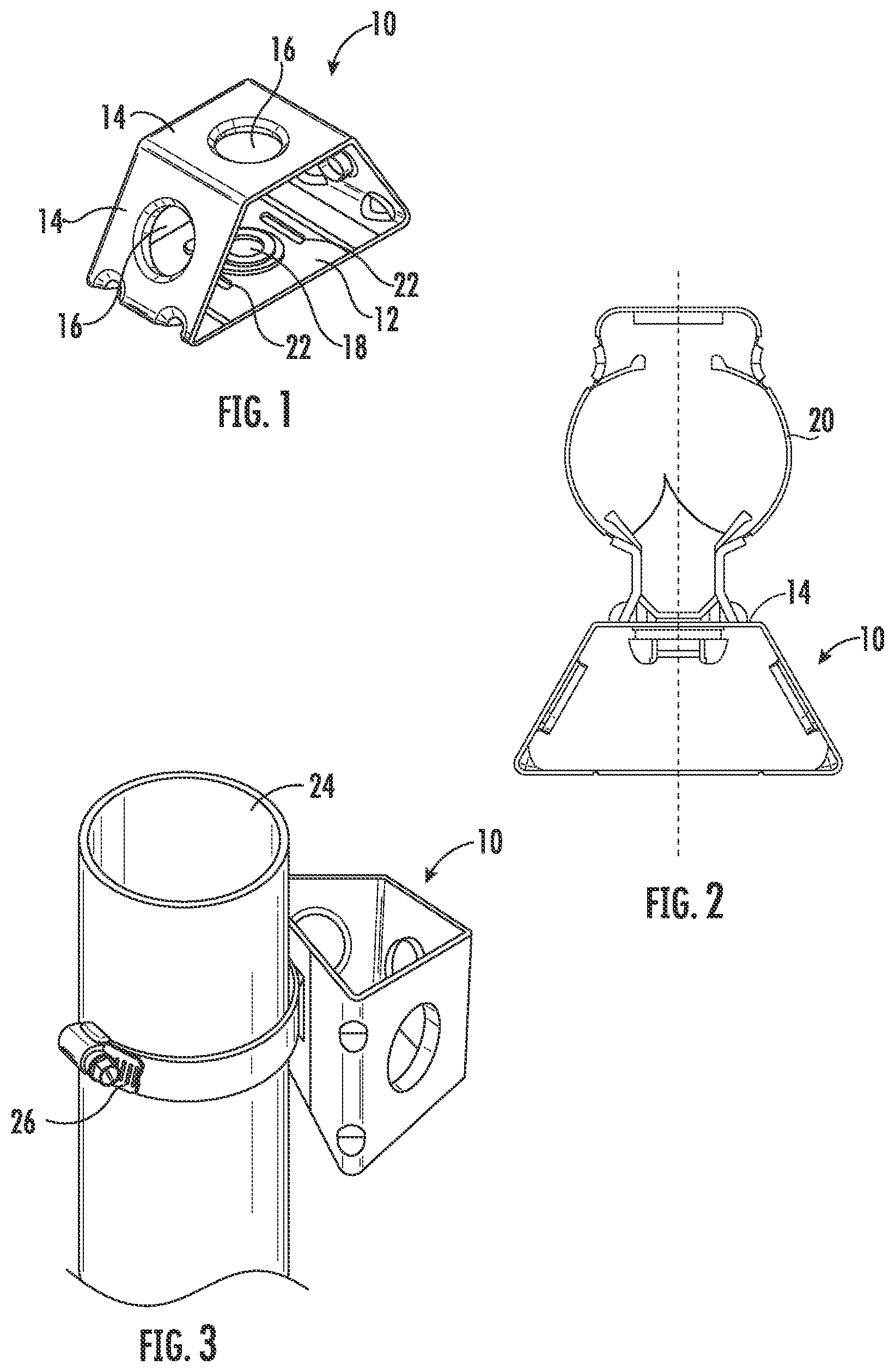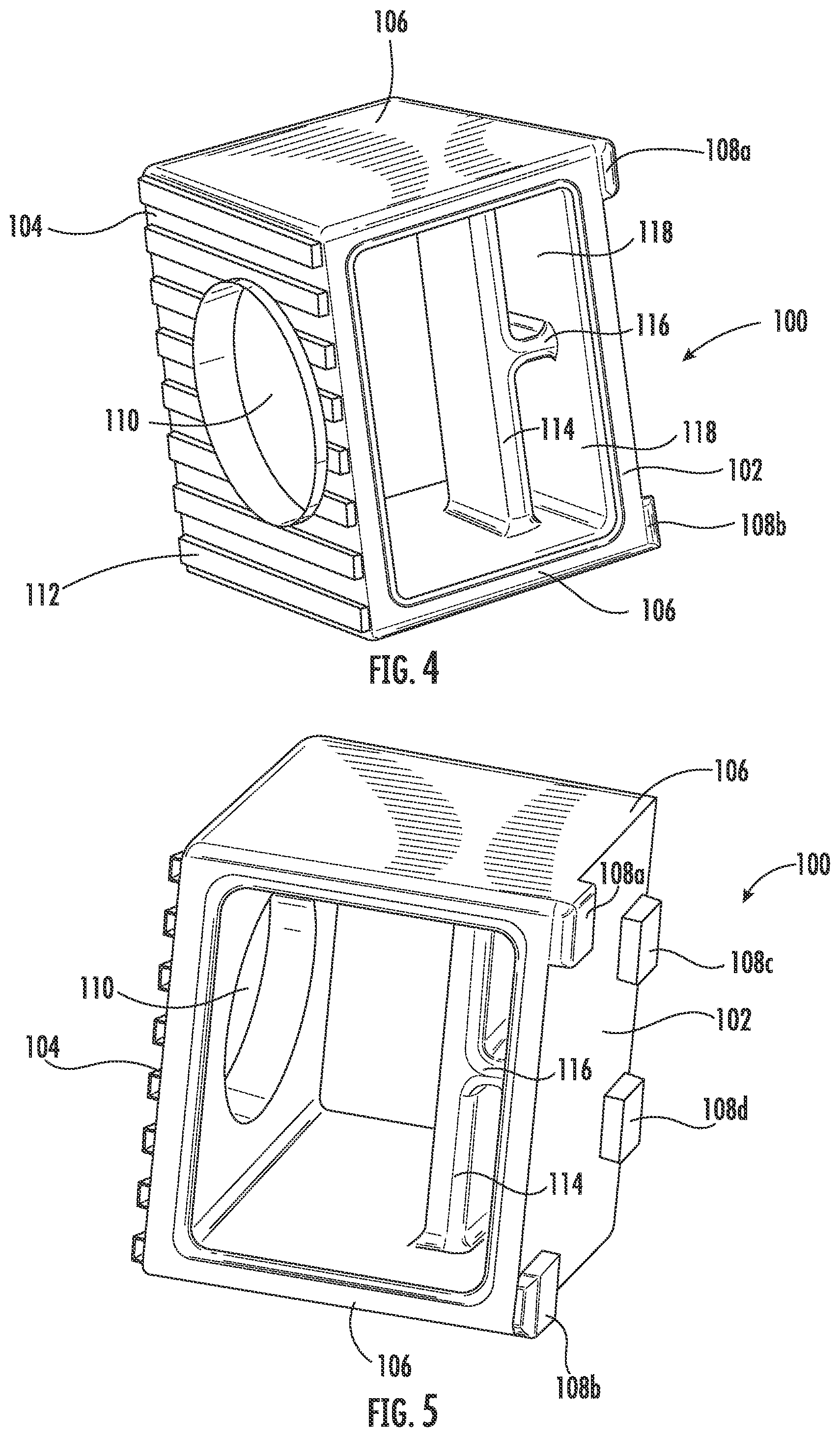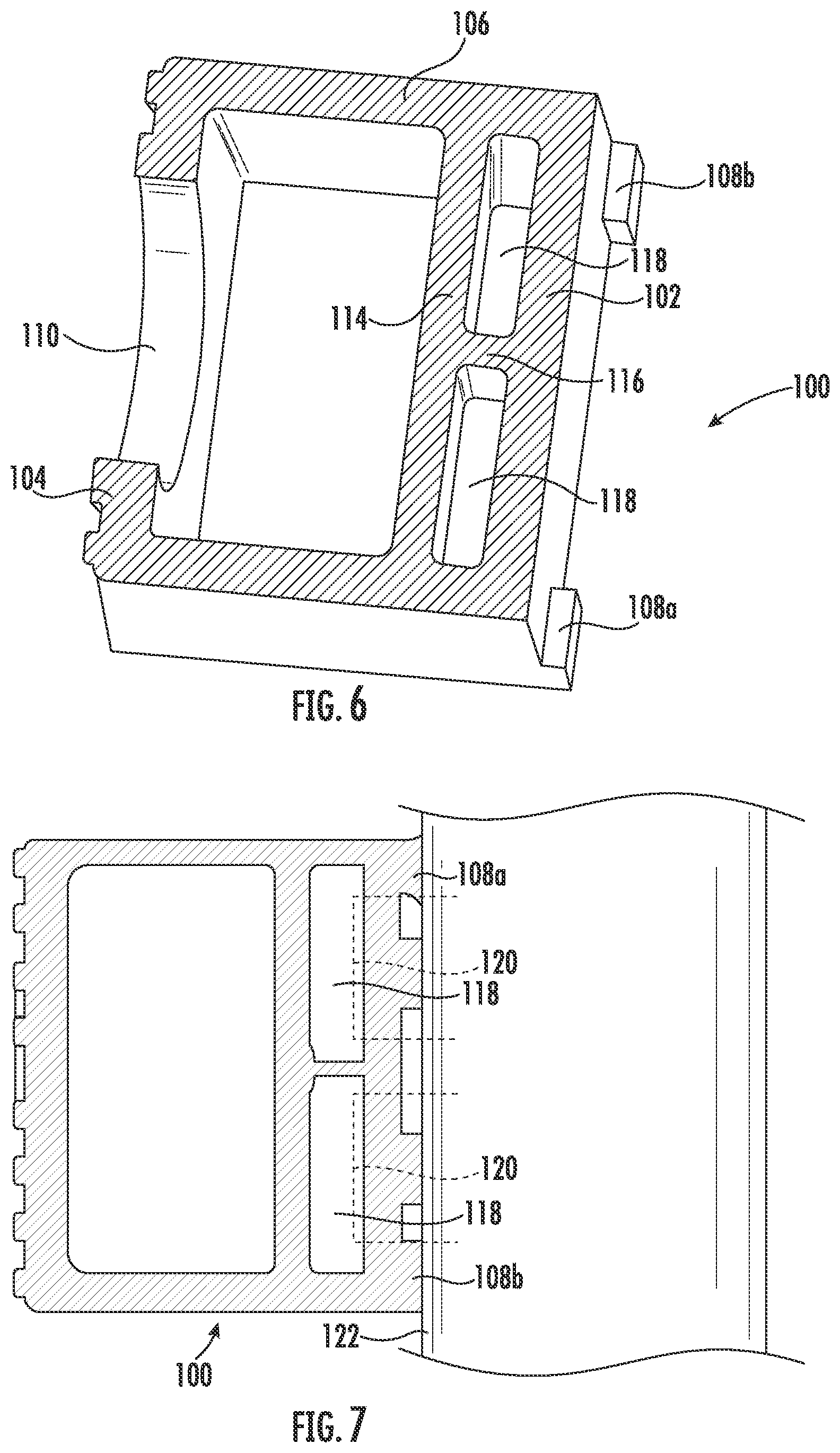Adapter For Mounting Cable Hangers
Vaccaro; Ronald A. ; et al.
U.S. patent application number 17/106238 was filed with the patent office on 2021-03-18 for adapter for mounting cable hangers. The applicant listed for this patent is CommScope Technologies LLC. Invention is credited to Aviral Joshi, Christopher Stockman, Ronald A. Vaccaro.
| Application Number | 20210080029 17/106238 |
| Document ID | / |
| Family ID | 1000005241735 |
| Filed Date | 2021-03-18 |





| United States Patent Application | 20210080029 |
| Kind Code | A1 |
| Vaccaro; Ronald A. ; et al. | March 18, 2021 |
ADAPTER FOR MOUNTING CABLE HANGERS
Abstract
An adapter for mounting cable hangers includes: a floor, a ceiling and side walls that span the floor and ceiling, wherein the ceiling includes a mounting hole; and a cross-member that extends between the side walls that defines at least one window between the cross-member, the floor and one of the side walls.
| Inventors: | Vaccaro; Ronald A.; (Taylorsville, NC) ; Joshi; Aviral; (Chicago, IL) ; Stockman; Christopher; (Joliet, IL) | ||||||||||
| Applicant: |
|
||||||||||
|---|---|---|---|---|---|---|---|---|---|---|---|
| Family ID: | 1000005241735 | ||||||||||
| Appl. No.: | 17/106238 | ||||||||||
| Filed: | November 30, 2020 |
Related U.S. Patent Documents
| Application Number | Filing Date | Patent Number | ||
|---|---|---|---|---|
| 16413246 | May 15, 2019 | 10851916 | ||
| 17106238 | ||||
| 62686882 | Jun 19, 2018 | |||
| Current U.S. Class: | 1/1 |
| Current CPC Class: | F16L 3/00 20130101; F16B 21/088 20130101; H02G 3/26 20130101 |
| International Class: | F16L 3/00 20060101 F16L003/00; H02G 3/00 20060101 H02G003/00; F16B 21/08 20060101 F16B021/08 |
Claims
1. An assembly, comprising: (a) an adapter for mounting cable hangers comprising: a floor, a ceiling and side walls, wherein the ceiling includes a mounting hole; a cross-member that extends between the side walls; and a divider that extends between the side walls and the floor, the floor, sidewalls and divider defining two windows; (b) two clamping bands, each of the clamping bands inserted into a respective one of the two windows; and (c) a cable hanger mounting in the mounting hole in the ceiling.
2. The assembly defined in claim 1, wherein the adapter is formed of a polymeric material.
3. The assembly defined in claim 1, wherein the adapter is a monolithic component.
4. The assembly defined in claim 1, wherein the adapter further comprises feet extending from the floor.
5. The assembly defined in claim 1, wherein the mounting hole has a nominal diameter of 3/4 inch.
6. The assembly defined in claim 1, wherein the clamping band is secured to a mounting structure.
7. The assembly defined in claim 6, wherein the clamping band is a radial clamp.
8. The assembly defined in claim 1, further comprising a cable mounted in the cable hanger.
9. An assembly, comprising: (a) an adapter for mounting cable hangers comprising: a floor, a ceiling and side walls, wherein the ceiling includes a mounting hole, the mounting hole having a nominal 3/4 inch diameter; a cross-member that extends between the side walls; and a divider that extends between the side walls and the floor, the floor, sidewalls and divider defining two windows; wherein the adapter is formed of polymeric material; (b) two clamping bands, each of the clamping bands inserted into a respective one of the two windows; and (c) a cable hanger mounting in the mounting hole in the ceiling.
10. The assembly defined in claim 9, wherein the adapter is a monolithic component.
11. The assembly defined in claim 9, wherein the adapter further comprises feet extending from the floor.
12. The assembly defined in claim 9, wherein the clamping band is secured to a mounting structure.
13. The assembly defined in claim 12, wherein the clamping band is a radial clamp.
14. An assembly, comprising: (a) an adapter for mounting cable hangers comprising: a floor, a ceiling and side walls, wherein the ceiling includes a mounting hole, the mounting hole having a nominal 3/4 inch diameter; a cross-member that extends between the side walls; and a divider that extends between the side walls and the floor, the floor, sidewalls and divider defining two windows; wherein the adapter is formed of polymeric material; (b) two radial clamps, each of the radial clamps inserted into a respective one of the two windows; (c) a cable hanger mounting in the mounting hole in the ceiling; and (d) a cable mounted in the cable hanger.
Description
RELATED APPLICATION
[0001] The present application is a continuation of and claims priority to U.S. patent application Ser. No. 16/413,246, filed May 15, 2019, now U.S. Pat. No. 10,851,916, which claims priority from and the benefit of U.S. Provisional Patent Application No. 62/686,882, filed Jun. 19, 2018, the disclosure of which is hereby incorporated herein by reference in its entirety.
FIELD OF THE INVENTION
[0002] The present invention relates generally to devices for supporting cables and, in particular, to hangers for securing cables to support structures.
BACKGROUND OF THE INVENTION
[0003] Cable hangers are commonly used to secure cables to structural members of antenna towers and/or along tunnel walls. Generally, each cable is attached to a structural member by cable hangers mounted at periodically-spaced attachment points.
[0004] Antenna towers and/or tunnels may be crowded due to the large numbers of cables required for signal-carrying. Over time, as systems are added, upgraded and/or expanded, installation of additional cables may be required. To conserve space, it may be desirable for each set of cable hangers to secure more than a single cable. Certain cable hangers have been constructed to secure multiple cables; other cable hangers have a stackable construction that permits multiple cable hangers to be interlocked extending outwardly from each mounting point/structural member. Stacked and multiple-cable-type cable hangers significantly increase the number of cables mountable to a single attachment point.
[0005] One popular stackable cable hanger is discussed in U.S. Pat. No. 8,191,836 to Korczak, the disclosure of which is hereby incorporated herein in its entirety. Hangers disclosed therein have generally a U- or C-shaped profile with rounded arms. A locking projection extends from the free end of each arm, and the "root" of the hanger that spans the fixed ends of the arms has a large aperture. The hanger can hold a cable between the arms; gripping of the cable is enhanced by short fingers that extend inwardly from the arms to engage the cable. The locking projections of a hanger are inserted into a hole in the antenna tower (typically in the leg of the antenna tower) to secure the hanger to the tower. Hangers can be "stacked" onto each other by inserting the locking projections of one hanger into the large aperture of the next hanger. One variety of cable hanger of this type is the SNAP-STAK.RTM. hanger, available from CommScope, Inc. (Joliet, Ill.). Other cable hangers are shown in U.S. Pat. No. 9,866,004, issued Jan. 4, 2018, U.S. Pat. No. 9,853,434, issued Dec. 26, 2017, and U.S. Pat. No. 9,903,510, issued Feb. 27, 2018, the disclosures of each of which are hereby incorporated herein by reference in full.
[0006] In some instances, it may be desirable to mount multiple stacks of cable hangers in close proximity. In such instances, it may be desirable to employ an adapter, such as that shown at 10 in FIG. 1. The adapter 10 has a trapezoidal profile, with a base panel 12 and three serially-attached mounting panels 14. Each of the mounting panels 14 includes a mounting hole 16 (typically a nominal 3/4 inch hole) that can receive a cable hanger such as those described above, one of which is designated 20 in FIG. 2. The base panel 12 of the adapter 10 has a hole 18 that can be used to mount the adapter 10 to a mounting structure via a bolt. The base panel 12 also includes slots 22 on either side of the hole 18 that can receive a hose clamp 26 or the like to mount the adapter 10 to a pole 24, as shown in FIG. 3. This mounting approach may be desirable when the pole 24 has no pre-formed holes to receive a typical cable hanger.
[0007] Areas near cellular antennas (i.e., within 1.lamda., or one wavelength) can be (relatively) high radio frequency (RF) energy environments. Conductive items in these areas, such as hangers and other hardware, can generate undesirable passive intermodulation (PIM). Typical examples of potential PIM-generating conditions include the combination of steel-on-steel contact (between two or more components), plus low contact pressure and/or relative movement between the steel components at the joint. As such, it may be desirable to provide solutions for hanging cables with reduced (or eliminated) likelihood of PIM generation.
SUMMARY
[0008] As a first aspect, embodiments of the invention are directed to an adapter for mounting cable hangers. The adapter comprises a floor, a ceiling and side walls that span the floor and ceiling, wherein the ceiling includes a mounting hole. The adapter further comprises a cross-member that extends between the side walls that defines at least one window between the cross-member, the floor and one of the side walls.
[0009] As a second aspect, embodiments of the invention are directed to an assembly comprising a mounting structure; first and second adapters as described above, a first radial clamp routed through the window of the first adapter and the window of the second adapter. The first radial clamp secures the first and second adapters to the mounting structure.
[0010] As a third aspect, embodiments of the invention are directed to an adapter for mounting cable hangers comprising: a floor; a ceiling; and side walls that span the floor and ceiling. The ceiling includes a mounting hole. The adapter further includes means to affix the adapter to a mounting structure.
BRIEF DESCRIPTION OF THE FIGURES
[0011] FIG. 1 is a perspective view of a prior art adapter for cable hangers.
[0012] FIG. 2 is a top view of the adapter of FIG. 1 with a cable hanger mounted therein.
[0013] FIG. 3 is a perspective view of the adapter of FIG. 1 mounted to a pole via a hose clamp.
[0014] FIG. 4 is a front perspective view of an adapter for cable hangers according to embodiments of the invention.
[0015] FIG. 5 is a rear perspective view of the adapter of FIG. 4.
[0016] FIG. 6 is a perspective section view of the adapter of FIG. 4.
[0017] FIG. 7 is a side view of the adapter of FIG. 4 mounted to a mounting structure via two hose clamps.
[0018] FIG. 8 is a schematic top view of three adapters of FIG. 4 mounted to a mounting structure with a common hose clamp.
DETAILED DESCRIPTION
[0019] The present invention is described with reference to the accompanying drawings, in which certain embodiments of the invention are shown. This invention may, however, be embodied in many different forms and should not be construed as limited to the embodiments that are pictured and described herein; rather, these embodiments are provided so that this disclosure will be thorough and complete, and will fully convey the scope of the invention to those skilled in the art. It will also be appreciated that the embodiments disclosed herein can be combined in any way and/or combination to provide many additional embodiments.
[0020] Unless otherwise defined, all technical and scientific terms that are used in this disclosure have the same meaning as commonly understood by one of ordinary skill in the art to which this invention belongs. The terminology used in the below description is for the purpose of describing particular embodiments only and is not intended to be limiting of the invention. As used in this disclosure, the singular forms "a", "an" and "the" are intended to include the plural forms as well, unless the context clearly indicates otherwise. It will also be understood that when an element (e.g., a device, circuit, etc.) is referred to as being "connected" or "coupled" to another element, it can be directly connected or coupled to the other element or intervening elements may be present. In contrast, when an element is referred to as being "directly connected" or "directly coupled" to another element, there are no intervening elements present.
[0021] Referring now to FIGS. 4-7, an adapter for mounting cable hangers, designated broadly at 100, is shown therein. The adapter 100 includes a floor 102, a ceiling 104 opposite the floor 102, and two side walls 106 that span the floor and the ceiling 104. As can be seen in FIG. 5, the floor 102 is narrower in width than the ceiling 104, such that each of the side walls 106 defines a trapezoidal or "wedge" shape. Four feet 108a-108d extend from the floor 102; in the illustrated embodiment, the feet 108a, 108b are located at two of the corners of the floor 102, whereas the feet 108c, 108d are located on the opposite edge from the feet 108a, 108b but are offset somewhat from the side walls 106 (in other embodiments, all four feet 108a-d may be located at the four corners of the floor 102). As shown in FIG. 4, the ceiling 104 includes a central hole 110; in some embodiments, the hole 110 is nominally 3/4 inch in diameter, and thus is sized for the insertion of cables hangers such as that shown at 20 in FIG. 2. Parallel reinforcing ribs 112 are also present on the ceiling 104.
[0022] The adapter 100 also includes a cross-member 114 that extends between the side walls 106 near the floor 102. A divider 116 extends between the cross-member 114 and the floor 102. The floor 102, cross-member 114 and divider 116 create two windows 118.
[0023] In some embodiments, the adapter 100 is formed of a polymeric material, such as acetal, polyethylene, polypropylene, PVC, or the like. The adapter 100 may be formed by injection molding. In the illustrated embodiment, the positioning of the feet 108a-d and the orientation of the ribs 112 and the windows 118 can enable the injection molding of the adapter 100 with a simple reciprocating mold that requires no "side-action" mechanism.
[0024] As can be seen in FIG. 7, the windows 118 serve as receptacles for hose clamps 120 or other fastening devices, such as other radial clamping devices like straps, cable ties, and twist ties, clips and the like. The two hose clamps 120 shown in FIG. 7 are routed through respective windows 118 and around a mounting structure, such as a post 122 of an antenna mount, a monopole, or the like. The feet 108a-d contact the surface of the mounting structure 122 to provide a more stable foundation for the adapter 100. Once mounted on the mounting structure, the adapter 100 is positioned to serve as a mounting point (via the central hole 110) for a cable hanger, such as that shown in FIG. 2. Adapters 100 formed of a polymeric material can be used to mount a metallic cable hanger without creating a potential site of undesirable PIM. Of course, those skilled in this art will appreciate that the polymeric cables hangers, such as those described in U.S. Pat. No. 10,253,906, issued Apr. 9, 2019 (incorporated by reference in full herein), may also be employed.
[0025] As shown in FIG. 8, multiple adapters 100 can be mounted at the same elevation with a single hose clamp 120 (or pair of hose clamps 120). Each of the hose clamps 120 is simply routed through one of the windows 118 of each adapter 100 and secured around the mounting structure 122. The trapezoidal profile of the adapter 100 can help to increase of maximize the number of adapters 100 placed side-by-side around the mounting structure 100.
[0026] It will also be appreciated that the adapter 100 may be configured such that the side walls 106 may include holes for mounting a cable hanger. Further, in some embodiments, the "open" sides of the adapter 100 may be at least partially closed with side walls, which side walls may include holes for mounting additional cable hangers.
[0027] The foregoing is illustrative of the present invention and is not to be construed as limiting thereof. Although exemplary embodiments of this invention have been described, those skilled in the art will readily appreciate that many modifications are possible in the exemplary embodiments without materially departing from the novel teachings and advantages of this invention. Accordingly, all such modifications are intended to be included within the scope of this invention as defined in the claims. The invention is defined by the following claims, with equivalents of the claims to be included therein.
* * * * *
D00000

D00001

D00002

D00003

D00004

XML
uspto.report is an independent third-party trademark research tool that is not affiliated, endorsed, or sponsored by the United States Patent and Trademark Office (USPTO) or any other governmental organization. The information provided by uspto.report is based on publicly available data at the time of writing and is intended for informational purposes only.
While we strive to provide accurate and up-to-date information, we do not guarantee the accuracy, completeness, reliability, or suitability of the information displayed on this site. The use of this site is at your own risk. Any reliance you place on such information is therefore strictly at your own risk.
All official trademark data, including owner information, should be verified by visiting the official USPTO website at www.uspto.gov. This site is not intended to replace professional legal advice and should not be used as a substitute for consulting with a legal professional who is knowledgeable about trademark law.